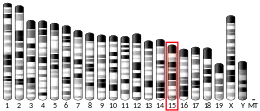DBX2
Homeobox protein DBX2, also known as developing brain homeobox protein 2, is a protein that in humans is encoded by the DBX2 gene.[5][6] DBX2 plays an important role in the development of the central nervous system, specifically in the development of the neural tube and brain.[7] DBX2 is located on chromosome 12 and is approximately 36,000 base pairs long. DBX2 is predicted to enable DNA-binding transcription activity as well as being involved in the regulation of transcription by RNA polymerase II.[8]
| DBX2 | |||||||||||||||||||||||||||||||||||||||||||||||||||
|---|---|---|---|---|---|---|---|---|---|---|---|---|---|---|---|---|---|---|---|---|---|---|---|---|---|---|---|---|---|---|---|---|---|---|---|---|---|---|---|---|---|---|---|---|---|---|---|---|---|---|---|
| Identifiers | |||||||||||||||||||||||||||||||||||||||||||||||||||
| Aliases | DBX2, developing brain homeobox 2 | ||||||||||||||||||||||||||||||||||||||||||||||||||
| External IDs | MGI: 107445 HomoloGene: 54981 GeneCards: DBX2 | ||||||||||||||||||||||||||||||||||||||||||||||||||
| |||||||||||||||||||||||||||||||||||||||||||||||||||
| |||||||||||||||||||||||||||||||||||||||||||||||||||
| |||||||||||||||||||||||||||||||||||||||||||||||||||
| |||||||||||||||||||||||||||||||||||||||||||||||||||
| |||||||||||||||||||||||||||||||||||||||||||||||||||
| Wikidata | |||||||||||||||||||||||||||||||||||||||||||||||||||
| |||||||||||||||||||||||||||||||||||||||||||||||||||
Identification
Dbx (developing brain homeobox) was first isolated from a gestational day 13.5 mouse in 1992.[9] There are two Dbx genes (DBX1 and DBX2) which are both important for development of the central nervous system. DBX2 shows conserved expression patterns in the developing brain and spinal cord and plays an important role in neural patterning and differentiation.
Associated Diseases
DBX2 has been found to play an important role in the development of Glioblastoma which is a lethal brain cancer with poor prognosis.[10] A high expression of DBX2 has been linked to large tumor size in Hepatocellular Carcinoma (HCC)[11] while a downregulated expression of DBX2 has been associated with Endometrial Cancer (EC).[12]
References
- GRCh38: Ensembl release 89: ENSG00000185610 - Ensembl, May 2017
- GRCm38: Ensembl release 89: ENSMUSG00000045608 - Ensembl, May 2017
- "Human PubMed Reference:". National Center for Biotechnology Information, U.S. National Library of Medicine.
- "Mouse PubMed Reference:". National Center for Biotechnology Information, U.S. National Library of Medicine.
- "Entrez Gene: developing brain homeobox 2".
- Pierani A, Moran-Rivard L, Sunshine MJ, Littman DR, Goulding M, Jessell TM (February 2001). "Control of interneuron fate in the developing spinal cord by the progenitor homeodomain protein Dbx1". Neuron. 29 (2): 367–84. doi:10.1016/S0896-6273(01)00212-4. PMID 11239429. S2CID 2647092.
- Ma, Pengcheng; Zhao, Shuhua; Zeng, Wanli; Yang, Qiutan; Li, Chaocui; Lv, Xiaoyan; Zhou, Qin; Mao, Bingyu (August 2011). "Xenopus Dbx2 is involved in primary neurogenesis and early neural plate patterning". Biochemical and Biophysical Research Communications. 412 (1): 170–174. doi:10.1016/j.bbrc.2011.07.068. PMID 21806971.
- "DBX2 Gene - GeneCards | DBX2 Protein | DBX2 Antibody". www.genecards.org. Retrieved 2022-04-01.
- Lu, S; Bogarad, L D; Murtha, M T; Ruddle, F H (September 1992). "Expression pattern of a murine homeobox gene, Dbx, displays extreme spatial restriction in embryonic forebrain and spinal cord". Proceedings of the National Academy of Sciences. 89 (17): 8053–8057. Bibcode:1992PNAS...89.8053L. doi:10.1073/pnas.89.17.8053. ISSN 0027-8424. PMC 49854. PMID 1355604.
- He, Ruixing; Zhang, Xiaotian; Ding, Lianshu (2021-08-30). "DBX2 promotes glioblastoma cell proliferation by regulating REST expression". Current Pharmaceutical Biotechnology. 23 (8): 1101–1108. doi:10.2174/1389201022666210830142827. ISSN 1873-4316. PMID 34463226. S2CID 237364818.
- Hu, Yan-Ting; Li, Bei-Fang; Zhang, Peng-Jun; Wu, Di; Li, Yan-Yan; Li, Zhong-Wu; Shen, Lin; Dong, Bin; Gao, Jing; Zhu, Xu (2019-02-28). "Dbx2 exhibits a tumor-promoting function in hepatocellular carcinoma cell lines via regulating Shh-Gli1 signaling". World Journal of Gastroenterology. 25 (8): 923–940. doi:10.3748/wjg.v25.i8.923. ISSN 2219-2840. PMC 6397724. PMID 30833799.
- Zhang, Xinlu; Wang, Yaping; Zhao, Shujun; Qin, Qiaohong; Zhang, Min; Jiang, Yi; Zhu, Hai; Li, Hongyu (2021). "Low expression of developing brain homeobox 2 (Dbx2) may serve as a biomarker to predict poor prognosis in endometrial cancer". American Journal of Translational Research. 13 (5): 4738–4748. ISSN 1943-8141. PMC 8205784. PMID 34150054.
This article incorporates text from the United States National Library of Medicine, which is in the public domain.



